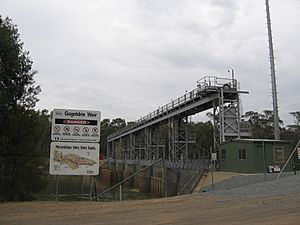Gogeldrie Weir facts for kids
Quick facts for kids Gogeldrie Weir |
|
|---|---|
 |
|
| Location | Murrumbidgee River, near Narrandera, Leeton Shire, New South Wales, Australia |
| Built | 1958–1959 |
| Architect | WC & IC |
| Official name: Gogeldrie Weir | |
| Type | State heritage (built) |
| Designated | 2 April 1999 |
| Reference no. | 961 |
| Type | Weir |
| Category | Utilities - Water |
| Builders | WC & IC |
| Lua error in Module:Location_map at line 420: attempt to index field 'wikibase' (a nil value). | |
The Gogeldrie Weir is a special structure on the Murrumbidgee River in New South Wales, Australia. It's located near the towns of Narrandera and Leeton Shire. This weir was built between 1958 and 1959 to help manage water for farming. Today, it's also a popular spot for recreation. Because of its importance, it was added to the New South Wales State Heritage Register in 1999.
Contents
Building the Gogeldrie Weir
The Gogeldrie Weir was finished in 1959. Its main job was to take water from the Murrumbidgee River. This water was then sent to two important farming areas: the Coleambally Irrigation Area and parts of the Murrumbidgee Irrigation Area.
Why the Weir Was Needed
The Coleambally Irrigation Scheme was a big government project. It aimed to help farming grow in the Coleambally region, which is south of the Murrumbidgee River. The scheme used water that was carefully controlled from other large projects, like the Snowy Scheme and the Blowering Dam.
The way Coleambally worked was similar to the Murrumbidgee Irrigation Area (MIA). The Gogeldrie Weir was the key starting point. It diverted water by gravity through a huge network of canals and channels. This allowed farmers to grow crops in an area that might otherwise be too dry. The first farms in this new scheme started operating in 1960.
What the Gogeldrie Weir Looks Like
The Gogeldrie Weir is one of seven major weirs built on the Murrumbidgee River. It is about 63 kilometers (39 miles) downstream from Narrandera. The weir itself is 85.34 meters (280 feet) wide between its support walls.
How the Weir Works
The weir is made of a strong concrete base, reinforced with steel. On top of this base are concrete piers (tall supports) and a steel frame. This frame holds the large steel sluice gates.
There are six gates in total. Each gate is 6.1 meters (20 feet) high and 12.2 meters (40 feet) wide. Each one weighs about 24 tonnes (26 short tons)! Electric motors open each gate individually, moving them up and down. Heavy counterweights help balance the gates as they move. These weights drop into special wells inside the concrete piers. The original system for controlling the gates was updated in 1996 with a computerised system.
Water Management
The weir creates a pool of water at a specific level. This level is perfect for sending water from the Murrumbidgee River into the Coleambally Canal. This canal supplies water to the Coleambally Irrigation Area. Water also flows through Coononcoocabil Lagoon into the Stuart Canal, which supplies other parts of the Murrumbidgee Irrigation Areas.
When the weir is at its full supply level, it can hold 7,400 megalitres (ML) of water. To give you an idea, a megalitre is a million liters! The two main canals can carry about 5,500 ML of water per day for long-term use. This huge amount of water is vital for farming in the region.
Why the Weir is Important
The Gogeldrie Weir is a very important part of the Coleambally Irrigation Scheme. It plays a key role in controlling and diverting water from the Murrumbidgee River to the Coleambally area. It's also connected to the Murrumbidgee Irrigation Area.
Because of its historical significance and its ongoing role in water management, the weir is considered a landmark in the region. It was officially listed on the New South Wales State Heritage Register on April 2, 1999.

